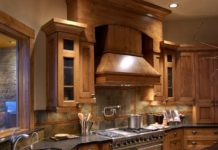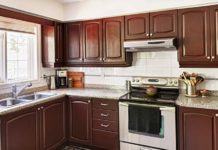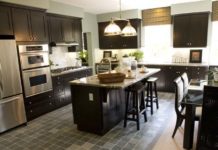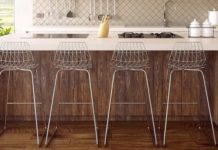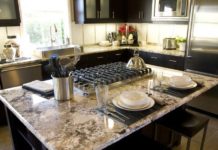
The kitchen has become one of the most important rooms in the house, the very hub of the home. But to make a kitchen work efficiently takes a lot of careful thought and planning, whether it is brand new or whether you are working on an existing kitchen to make it suit your needs.
Once you are happy with the general plan, including fitted cupboards, shelves and so on, and the kitchen is up and working, you can add decorative finishes that will give it character and the kind of ambiance you prefer.
There are usually three main work or activity areas in the kitchen, one for cooking, one for washing up dirty dishes or rinsing fresh foodstuffs, and the other for food storage, more specifically cold food storage. If you are planning a kitchen from scratch you will need to ensure that these three areas work together. They need to be reasonably self-contained (in that everything you need should be in that particular space), but also logically related to one another so that whoever is doing the cooking can move from one area to the other easily. You will see that these three work area relate primarily to appliances, namely:
- stoves, hobs and ovens,
- refrigerators and deep freezes, and
- sinks, which might incorporate a dishwasher and/or a waste disposal unit.
Apart from this, while some kitchens do feature freestanding furniture, including tables, chairs and dressers, the rest of the room is more commonly fitted with various cupboards and cabinets. These are designed for storing just about everything from pots and pans, crockery and cutlery, to foodstuffs that don’t have to be stored in a refrigerator.
Because we also need work surfaces, in particular for food preparation, kitchen cupboards commonly come in both floor standing (tall or counter height) and wall hung designs. Of course, what this means is that the upper surface of counter height kitchen units instantly become work surfaces. But it also means that there will be a section of wall space between counter height floor standing and wall hung cupboards, and more often than not, also an awkward bit of wall between the top of the wall hung cupboards and the ceiling. So when it comes to decorating, you’re going to have to decide how to finish both the top and middle sections of exposed wall.
When it comes to decorating above cupboards in the kitchen, you won’t necessarily follow the same process chosen for the middle bit between wall hung and floor standing cupboard units. This is because a lot of people choose to tile between units, so that the backing behind the work surface is easy to keep clean. But there is absolutely no point in tiling above wall hung cupboards. Apart from anything else, this area is too difficult to access on a daily basis, to clean.
So what are your options?
Painting this area is probably the most obvious choice. Choose a color that will match the rest of the room or tone with it. Then, if you want to add some sort of decoration, consider stenciling a pretty border pattern just under the ceiling or the cornice, if there is one.
Wallpaper is another option, but only suitable if there are other larger wall areas that are wallpapered. Otherwise this touch is likely to simply look odd. You could, however, paste a wallpaper border under the cornice. That can look quite attractive. Just choose a color and pattern that will work with other colors and patterns used elsewhere in the room, for blinds or curtains or even table cloths and other table dressings.
Otherwise you could hang plates above the units, to add color and interest. It isn’t usually a space that is suitable for pictures though.
Another possibility for decorating above cupboards in the kitchen is to use the upper surface of wall-hung cupboards to display interesting or decorative items. These could be anything from baskets to attractive pots of pickles, preserves and jams. If you’re into making pickles and jams, this approach can be quite useful, because these foodstuffs (particularly pickles and preserves) often have to sit for a while before you can eat them. So this becomes a functional as well as a decorative exercise.
You could also use the tops of wall-hung cupboards to double as a more conventional storage space, as long as what you are storing looks attractive, shining copper or stainless steel pots for example, or perhaps teapots or jugs. There is an obvious down-side to this idea, and that is that anything stored out of cupboards will get dusty and possibly grimy within quite a short space of time. This means you will need to be reasonably vigilant when it comes to dusting and cleaning.
If you want a nice, clean-looking, streamlined kitchen, then you shouldn’t draw attention to the space above wall hung or tall floor standing kitchen cupboards. Instead, go back to basics and paint the wall the same color as any other walls that have been painted. In the event of all other exposed wall areas being tiled, then paint it the same color as the ceiling, or the same color as the cupboards themselves.
Also remember that when it comes to decorating above cupboards in the kitchen, you should not think of this area as a separate entity. At the end of the day, you should be aiming for a look that will work for the whole room, in terms of style, theme and colors used. It really doesn’t matter what approach you take, as long as it works for you and your family.
Finally, you will also need to think about spaces above your appliances, depending on their height. You may be able to mount cupboards or shelves above a refrigerator, and you can usually install a microwave oven within special units. But sinks and other cooking appliances can be more difficult to deal with. Look at photographs of kitchens in magazines, books and on the Internet, and don’t be afraid to use your own creativity.

